Elizabeth Trout

| To celebrate International Women’s Day this week (8 March) this newsletter features an interesting woman who played an important role in the early history of mill preservation. This is reproduced from a blog by Elizabeth Trout, originally published on our website in 2020. |
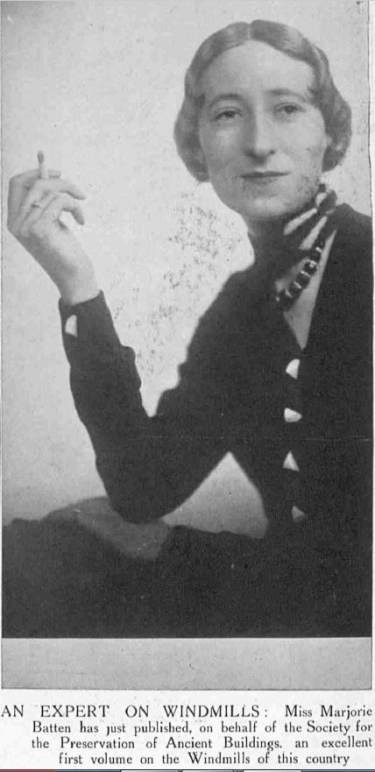
M. I. Batten is the author of English Windmills Volume 1 which was published by the Architectural Press in 1930. We have a copy in the Mills Archive Library available to visitors and also in our book shop to purchase here. However, it is only through our work on the Rex Wailes Collection that we are understanding how significant this book is and the part Marjorie Batten played in the early days of the SPAB Mills Section.
This volume is important because it comes just a year after the SPAB Windmills Fund was launched in June 1929 to raise money for the preservation of windmills.
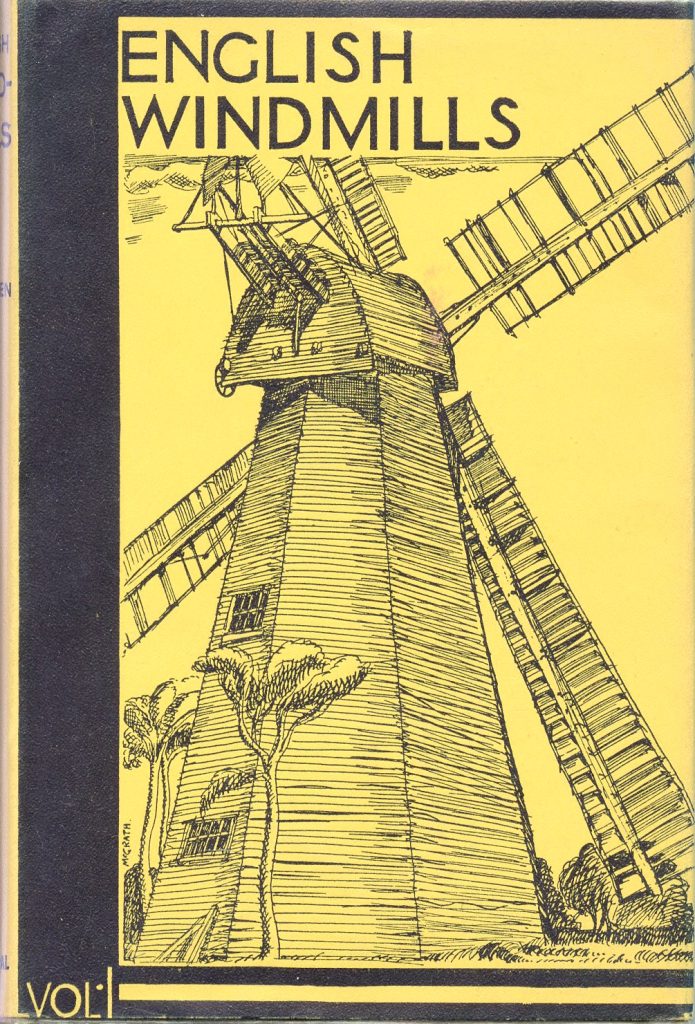
| The Windmill Campaign was launched when the Daily Mail asked Miss Batten to write an article about the plight of windmills in June 1929. A copy of the Daily Mail press cutting was found recently in the Rex Wailes Collection. |

| The first report of the Windmill Fund was produced in the SPAB Annual Report 1930 [1]. On the list of committee members and honorary positions is Hon. Secretary to the Windmill Fund Miss M. I. Batten. In 1930, Miss Batten was one of a small number of pioneering women who were making their mark in the preservation of historic buildings and mills. Genealogical research has uncovered her name to be Marjorie Isabel Batten. She was born in Kensington in 1903, daughter of Holgate Batten, a land agent, and Jane Forbes of Scotland. Marjorie had two older brothers, John Forbes Batten and Stephen Alexander Holgate Batten. The family lived at Moorlands, Horsell, Woking but then moved to Folkestone, Kent by 1911. Marjorie was an art historian by training and was elected to SPAB in 1928, possibly through her brother John Forbes Batten who was also a member. In 1930, she was appointed Secretary of the Windmill Fund and was on the SPAB Windmill Committee from 1931 to 1934, serving as its Secretary until 1931 when Miss H. Lloyd took over. As a result of the Daily Mail item, SPAB was inundated with correspondence and mill photographs which must have taken up a lot of Marjorie’s time acknowledging them all. The Press interest was such that she sent further letters appealing for funds to preserve windmills. These appeared in many papers including The Times, Daily Telegraph, Morning Post, Manchester Guardian, Evening News, Country Life and The Field. Two leading articles on windmills with photographs were also published in The Times. |
In the correspondence files of the Rex Wailes Collection there are several letters sent to Rex Wailes from Miss M. I.Batten in her capacity of Honorary Secretary. At the time Rex was just an engineer interested in mills but very involved in the Windmill Campaign. In a letter to Rex Wailes on 29 November 1929, Marjorie outlines a plan for the lecture which she had mentioned in a telephone call to him that day.
In the letter she explains that the idea for a talk or lecture was suggested in a letter she received from Mr Jan den Tex, Secretary of the Dutch Windmill Preservation Society. He was very keen to visit England to talk about the Dutch approach to windmill preservation. Simultaneously, she received a letter from Mr Rupert Thompson, Chairman of the National Trust Publicity Committee who knew Jan den Tex and was keen for National Trust members to be invited to the lecture.
Marjorie formulated a plan, agreed with Mr Powys the Secretary of SPAB, took the initiative and provisionally booked the lecture room at the Society of Arts which held about 200 people on a date to be decided.
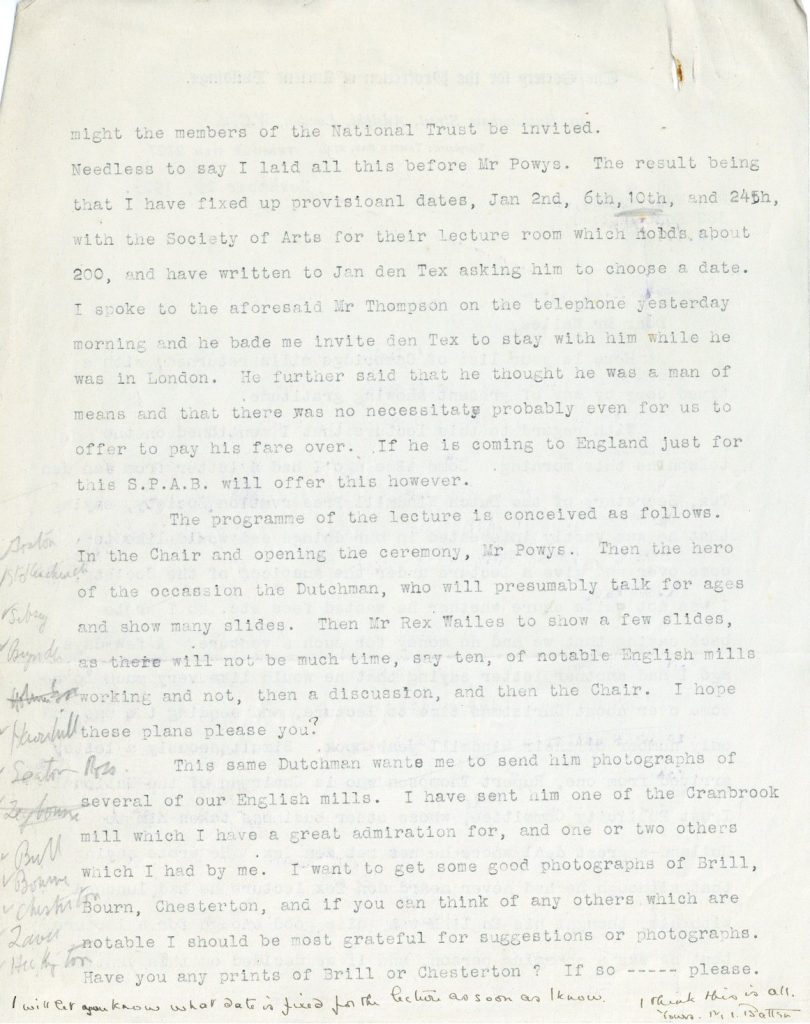
| She outlined her ideas to Rex of how the event would unfold, calling Jan den Tex ‘ the hero of the hour’. She suggests that Rex show some slides on English windmills – Cranbrook, Brill, Bourn and Chesterton. She signs off in her characteristically tiny writing. In the margin, Rex has created an additional list of mills to be included. |
Rex Wailes replied on 2 December 1929 and suggests some more mills to include in his slideshow and how long he might speak for – 10 slides in 15 minutes, speaking for a minute and a half on each slide!
He also suggested that he could display some 18th century Dutch milling books from his collection.
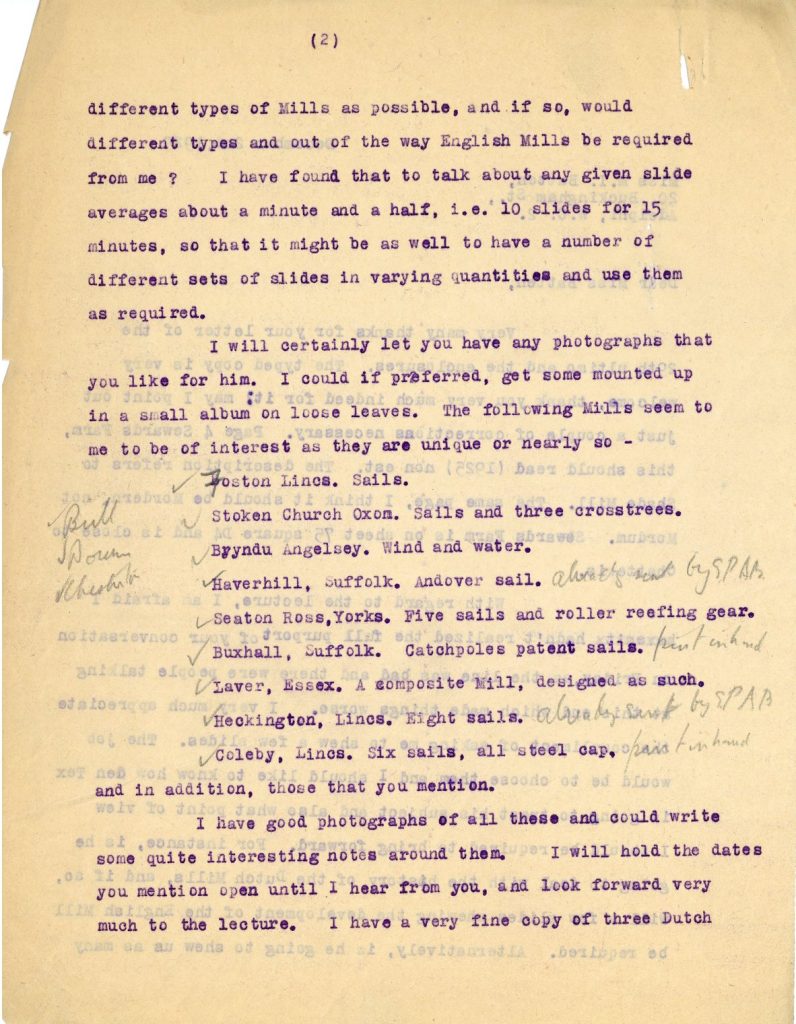
| The Science Museum also lent a fine scale model of Cranbrook windmill which Rex demonstrated. |

photograph by Kenneth G Farries (Mills Archive Collection, KGFC-GPN-E-082)
| In 1930, Marjorie wrote two letters to Rex in a more informal style which hint at her personality and life outside SPAB. One gets the impression that she was an enthusiastic and intelligent woman. |
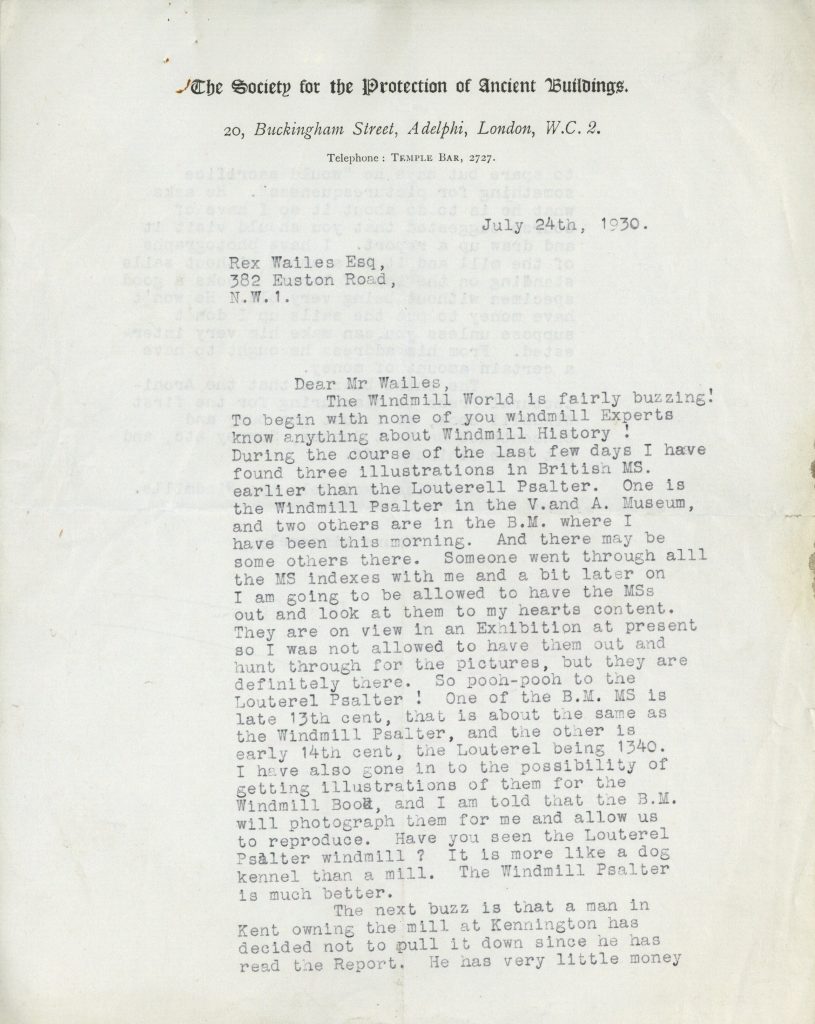
| Marjorie’s catchphrase was “buzz” or “buzzing”. She was very excited that she had found three illustrations of windmills earlier than the Lutteral Psalter. The Architectural Press had also offered to publish her book. |
In the Foreward, she acknowledges the help of several eminent mill experts: William Coles-Finch who allowed her to reproduce his photographs in the book; Jack Holman (millwright of Canterbury) who sent photographs and information; H P Vowles who sent a copy of his paper on the origin of windmills read at the Newcomen Society; and Rex Wailes. Wailes also wrote the second chapter of this book – Design and Development.
When the book was published, she asked Rex to approach The Sphere to publicise her book. This magazine had a wide circulation. Marjorie’s glamourous photograph (at the head of this article) appeared in the edition of March 21, 1931 on a page of other notable women including a Duchess, a Countess, the actress Fay Wray, and Fraulein Margarethe Guessow, Germany’s only female astronomer.

block
This last letter relates to when Marjorie handed over the Honorary Secretary role to Miss Lloyd, although she continued to serve the SPAB Windmill Committee until her marriage in 1934 to Col. Geoffrey Fairbank Webb [2]. She obviously liked to live well, eating oysters for lunch at the Albemarle Club! This club was unusual in being a private members club for men and women and progressive in supporting women’s rights. Members were aesthetes, artists and intellectuals (The Albemarle Club was absorbed into the ‘In and Out Club’ in 1939).
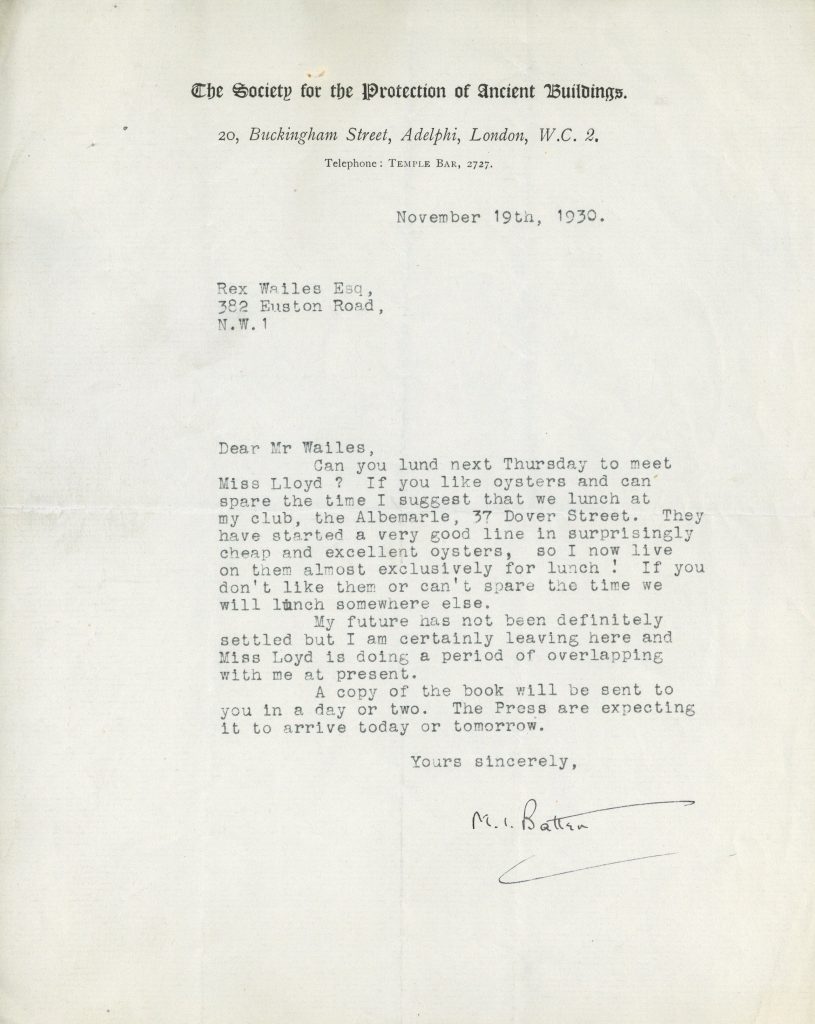
Little seems to be recorded of Marjorie after her marriage. Volume 2 of English Windmills was written by Donald Smith and published in 1932. Marjorie suffered declining health and passed away in 1962. The SPAB Windmill Committee in their 1961-62 report [3] expressed “deep regret of the death of Mrs Geoffrey Webb”. Her book English Windmills volume 1 was described as “a pioneer work of the utmost interest and lasting value. It was through Mrs Webb that the Ministry of Works was approached by the Section and encouraged to take certain mills under their guardianship”. |
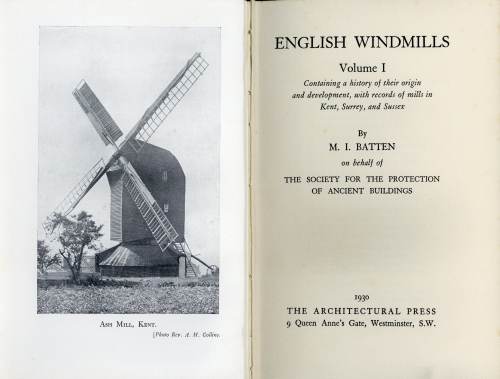
| [1] Society for the Protection of Ancient Buildings Fifty-Third Annual Report of the Committee, April 1930 [2] Col. Geoffrey Fairbank Webb (1898-1970) was an architectural historian, Slade Professor of Fine Art at Cambridge and head of the Monuments and Fine Arts Section of the Allied Control Commission during World War II. His biography can be read here [3] SPAB The Wind and Watermill Section Report of the Committee for the Thirtieth-Thirty-First Year 1961-1962 |
